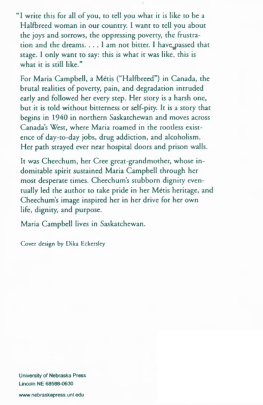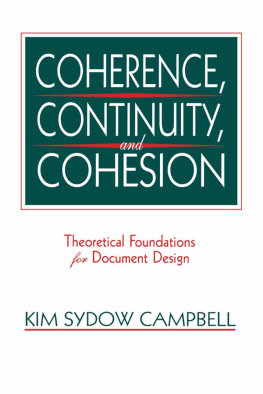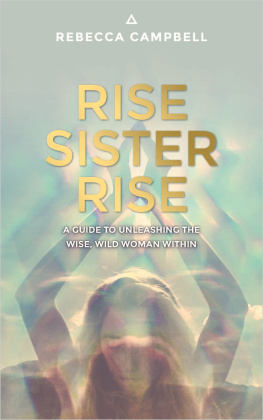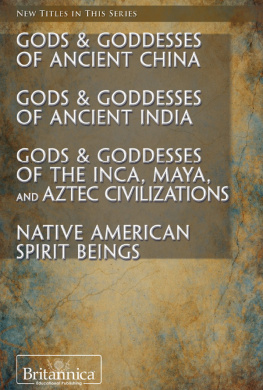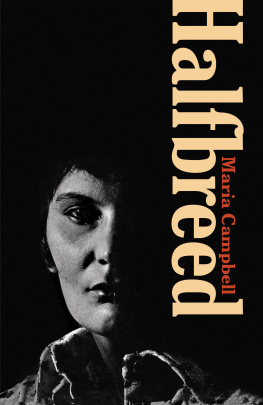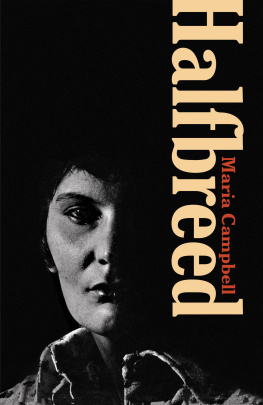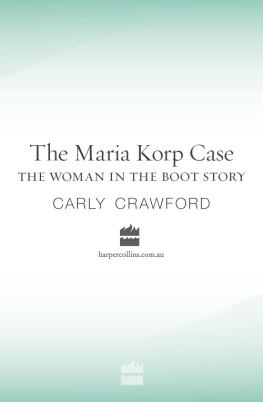

Copyright 1973 by Maria Campbell
All rights reserved
Library of Congress Cataloging in Publication Data
Campbell, Maria, 1940
Halfbreed.
1. Campbell, Maria, 1940-. 2. Cree IndiansBiography. 3. Indians of North AmericaCanadaMixed bloodsBiography. I. Title.
E99.C88C254 1982 970.00497 [B] 82-8382
AACR2
ISBN-13: 978-0-8032-6311-6 (paper: alk. paper)
ISBN-13: 978-0-8032-6280-5 (electronic: e-pub)
ISBN-13: 978-0-8032-6281-2 (electronic: mobi)
The publisher does not have any control over and does not assume any responsibility for author or third-party websites or their content.
This book is dedicated to my Cheechums children. Thank you Stan Daniels for making me angry enough to write it; Peggy Robbins, for your understanding and encouragement but especially for believing I could do it; my family, for your patience; Elaine, Kay, Sheila, Sarah and Jean, for understanding, listening, typing and babysitting; and a special thank-you to my friend Dianne Woodman.
Introduction
The house where I grew up is tumbled down and overgrown with brush. The pine tree beside the east window is dried and withered. Only the poplar trees and the slough behind the house are unchanged. There is a family of beavers still there, busy working and chattering just as on that morning, seventeen years ago, when I said good-bye to my father and left home.
The graveyard down the hill is a tangle of wild roses, tiger lilies and thistle. The crosses are falling down and gophers scurry back and forth over the sunken graves. The old Roman Catholic church still needs repainting but because of the poverty of the congregation it continues to wait until another year.
The blacksmith shop and cheese factory across the road have long since been torn down and only an old black steam-engine and forgotten horseshoes mark the place where they once stood. The store is still there, old and lonely, looking like the country around it, and, like the people it serves, merely exists. The French owners who came from Quebec are dead and their families have gone. It is as if they were never there.
Grannie Campbells house is gone. The Halfbreed families who squatted on the road allowances have moved to nearby towns where welfare hand-outs and booze are handier, or else deeper into the bush as an escape from reality. The old people who were so much a part of my childhood have all died.
Going home after so long a time, I thought that I might find again the happiness and beauty I had known as a child. But as I walked down the rough dirt road, poked through the broken old buildings and thought back over the years, I realized that I could never find that here. Like me the land had changed, my people were gone, and if I was to know peace I would have to search within myself. That is when I decided to write about my life. I am not very old, so perhaps some day, when I too am a grannie, I will write more. I write this for all of you, to tell you what it is like to be a Halfbreed woman in our country. I want to tell you about the joys and sorrows, the oppressing poverty, the frustrations and the dreams.
Chapter 1
In the 1860s Saskatchewan was part of what was then called the Northwest Territories and was a land free of towns, barbed-wire fences and farm-houses. The Halfbreeds came here from Ontario and Manitoba to escape the prejudice and hate that comes with the opening of a new land.
The fear of the Halfbreeds that their rights would not be respected by the Canadian government when it acquired the land from the Hudsons Bay Company, along with the prejudice of the white Protestant settlers, led to the Red River Rebellion of 1869. Louis Riel established a provisional government at Fort Garry, Manitoba, but escaped to the United States in 1870 when troops arrived from eastern Canada.
So with their leaders and their lands gone, the Halfbreeds fled to the areas south of Prince Albert, Saskatchewan, and established the settlements of Duck Lake, Batoche, St. Louis and St. Laurent. There was no government in Saskatchewan at the time and no law and order, so they formed their own, fashioned after their way of life the order and discipline of the great Buffalo Hunts. They elected Gabriel Dumont as their president, and with him eight councillors. They set up laws by which the people could live peaceably, and penalties if the laws were broken. They made it clear that they werent opposed to the Canadian government and would abandon their council as soon as the Territories acquired a true government and was able to establish law and order.
Here, for a very few years they lived happily, but the 1870s and 1880s brought the settlers and the railroad, and just as had happened in Ontario and Manitoba their way of life was again threatened. They were squatters with no title to the land they lived on. They wanted assurance from Ottawa of their right to keep the land before the incoming white settlers encroached on them by using homestead laws. Our people believed the lands acts discriminated against them, stating that they had to live on the land and wait three years before filing a claim. They had lived on the lands for years before the lands acts had even been thought of, and didnt believe they should be treated like newcomers. They sent many petitions and resolutions to Ottawa but again, as in Ontario and Manitoba, Ottawa was not interested and continued to ignore their existence.
Finally, in 1884, they decided to ask the only man who could help them. Gabriel Dumont and three of his councillors rode to Montana to see Louis Riel who was living in exile. Riel returned with them to Saskatchewan to discover that it was not only Halfbreeds who had reasons to complain but white settlers and Indians as well. Because of pressing demands in the east, Macdonalds Conservative government had cut federal monies going to the Territories. This left the Indians without the rations and farming assistance promised to them under the treaties. The white settlers had suffered one disaster after another including three years of drought this, together with their dissatisfaction over the lands claims acts, had completely soured them against the federal government.
This time petitions and resolutions went to Ottawa from white settlers, Halfbreeds and Indians. Again Ottawa ignored them. The Halfbreeds by now were angry and ready to take up arms but Riel and the white settlers didnt want a rebellion. Riel believed there had to be a more peaceful way to make Ottawa realize the urgency of their requests. Dumont, however, had no faith in the federal government he believed only an armed rebellion would give them what they asked for. He urged Riel to seize Fort Carlton and to declare a provisional government as he had done at Fort Garry in Manitoba. Finally Riel took Dumonts advice and established a provisional government. He gave the North West Mounted Police at the Fort an ultimatum to surrender or they would attack. Meanwhile, Dumont had gathered together a party of armed Halfbreeds and Indians, and without Riels knowledge approached the Fort. Crozier, the NWMP officer in charge of the Fort, had sent to Regina for reinforcements when he received Riels ultimatum. However, on seeing Dumont and his party approaching, Crozier decided, very foolishly, to take his inexperienced troops out against Dumonts skilled sharp-shooters.
This was the Battle of Duck Lake, a victory for the Halfbreeds, and was the beginning of the Riel Rebellion. The majority of white settlers didnt want violence and withdrew their support after Duck Lake, but the treaty Indians, who were starving because of Ottawas broken promises, supported Dumont and Riel. Poundmaker and Big Bear, chiefs renowned as warriors and respected throughout the Territories, brought their warriors to join forces with the Halfbreeds.
Next page
